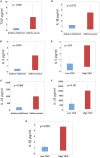TSLP bronchoalveolar lavage levels at baseline are linked to clinical disease severity and reduced lung function in children with asthma
- PMID: 36245744
- PMCID: PMC9557150
- DOI: 10.3389/fped.2022.971073
TSLP bronchoalveolar lavage levels at baseline are linked to clinical disease severity and reduced lung function in children with asthma
Abstract
Rationale: Thymic stromal lymphopoietin (TSLP) is increasingly recognized as a key molecule in asthma pathogenesis and as a promising therapeutic target in adults. In contrast, in asthmatic children the clinical relevance of TSLP secretion in the lower airways has been remarkably understudied. We tested the hypothesis that pulmonary TSLP levels in asthmatic children correlate with clinical severity, airway inflammation and lower airway obstruction.
Methods: Bronchoalveolar lavage (BAL) samples and relevant clinical data were collected from asthmatic children undergoing clinically indicated bronchoscopy at Children's National Hospital in Washington D.C. Protein levels of TSLP, IL-5, IL-1β, and IL-33 were quantified in BAL at baseline and correlated with individual severity and clinical features including spirometry, serum IgE and eosinophils, BAL neutrophil and eosinophil counts.
Results: We enrolled a total of 35 asthmatic children (median age: 9 years). Pediatric subjects with severe asthma had greater TSLP BAL levels at baseline relative to mild or moderate asthmatic subjects (p = 0.016). Asthmatic children with the highest TSLP levels (>75th percentile) had higher IL-5 and IL-1β BAL levels and greater lower airway obstruction (lower FEV1/FVC ratios).
Conclusion: Our study demonstrates for the first time that higher pulmonary TSLP levels obtained at baseline are linked to asthma disease severity in a subset of children. These data indicate that TSLP may play a key role in the pathogenesis of pediatric asthma and thus provide initial support to investigate the potential use of anti-TSLP biologics to treat severe uncontrolled asthmatic children.
Keywords: BAL (bronchoalveolar lavage); TSLP; asthma; children; lung.
Copyright © 2022 Chorvinsky, Nino, Salka, Gaviria, Gutierrez and Pillai.
Conflict of interest statement
The authors declare that the research was conducted in the absence of any commercial or financial relationships that could be construed as a potential conflict of interest.
Figures


Similar articles
-
Elevated Expression of IL-33 and TSLP in the Airways of Human Asthmatics In Vivo: A Potential Biomarker of Severe Refractory Disease.J Immunol. 2018 Apr 1;200(7):2253-2262. doi: 10.4049/jimmunol.1701455. Epub 2018 Feb 16. J Immunol. 2018. PMID: 29453280
-
TSLP directly impairs pulmonary Treg function: association with aberrant tolerogenic immunity in asthmatic airway.Allergy Asthma Clin Immunol. 2010 Mar 15;6(1):4. doi: 10.1186/1710-1492-6-4. Allergy Asthma Clin Immunol. 2010. PMID: 20230634 Free PMC article.
-
Airway eosinophilic inflammation, epithelial damage, and bronchial hyperresponsiveness in patients with mild-moderate, stable asthma.Allergy. 1996 Feb;51(2):100-7. doi: 10.1111/j.1398-9995.1996.tb04565.x. Allergy. 1996. PMID: 8738515
-
IL-5 production by bronchoalveolar lavage and peripheral blood mononuclear cells in asthma and atopy.Eur Respir J. 1997 Mar;10(3):624-32. Eur Respir J. 1997. PMID: 9072996
-
The added value of targeting airway hyperresponsiveness by blocking TSLP in the management of severe asthma.Eur Ann Allergy Clin Immunol. 2024 Nov 15. doi: 10.23822/EurAnnACI.1764-1489.376. Online ahead of print. Eur Ann Allergy Clin Immunol. 2024. PMID: 39545827 Review.
Cited by
-
Thymic Stromal Lymphopoietin (TSLP): Evidence in Respiratory Epithelial-driven Diseases Including Chronic Rhinosinusitis with Nasal Polyps.Curr Allergy Asthma Rep. 2024 Dec 5;25(1):7. doi: 10.1007/s11882-024-01186-2. Curr Allergy Asthma Rep. 2024. PMID: 39636450 Review.
-
The Role of Alarmins in the Pathogenesis of Asthma.Biomolecules. 2025 Jul 11;15(7):996. doi: 10.3390/biom15070996. Biomolecules. 2025. PMID: 40723867 Free PMC article. Review.
References
LinkOut - more resources
Full Text Sources

